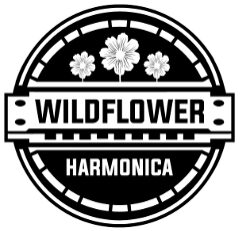Sometimes it helps to have a roadmap.
1. Breathing comfortably.
2. Single notes.
3. Bending.
4. Tongue, Hand, and Breath Effects.
5. Overblows.
Breathing Comfortably
Just by breathing in and out and sliding back and forth, the harmonica makes musical sounds. I mentioned this in the What You Need post. You’re allowed to just mess around and make sounds. Play long notes, play short notes. Make “Tah-tah-tah” sounds with your tongue. Explore. Enjoy it! By the way, even without single notes, you can play recognizable songs. Just aim approximately for the hole numbers on the tab page and you’ll be able to hear the song start to emerge. Good enough. We’re here to have fun, you know.
Single Notes
As you learn to play clear single notes on the harmonica, your melodies will sound better and better. Play scales and scale patterns, too, they’ll help your basic technique a lot. Single notes represent a really exciting stage, since there are now hundreds, if not thousands, of melodies you can play which don’t require anything more than single notes on holes 4-10. You still have to develop your ear – it helps to sing along to your melodies and learn to tap your foot.
Bends
Bending notes will give you bluesy sounds and fill in the missing notes from holes 1-4 which some melodies require. To bend, you gotta have your single notes nailed. If you’re trying to bend but you hear two notes coming through, your air is being cut in half and it becomes a lot harder to control the reed you’re aiming for. Generally, you want to get your draw bends down (1-6) and then your blow bends (7-10).
Tongue, Hand, and Breath Effects
I’m talking here about cupping your hands to make a “wah-wah” sound, touching the comb with your tongue so you play one hole out of each corner of your mouth, flicking your tongue to switch between notes, and pulsing your breath and bending slightly to get a vibrato effect. You can actually start on some of this stuff earlier than this, I’ve just listed it as #4 since Breath, Single Notes, and Bends are, in my opinion, more important in the long run. But these effects are really fun and sound cool, and are necessary for traditional blues styles.
Overblows
Overblows are an extension of your bending technique, and they fill in the rest of the missing notes on the diatonic harmonica. You have to be able to bend consistently and accurately in order to play overblows, and there’s a small adjustment we’ll need to make to the reeds, bending them slightly closer to the reedplate so they’ll choke more easily. Whether or not you even NEED overblows is a question for another day. They’re not terribly hard to play if you can bend accurately, but they do require some reed adjustment, and you’ll probably need to learn some music theory.
The Big Picture
We haven’t talked here about repertoire, but let’s just note: this list is about technique. At each stage, you’ll want to be learning songs, playing with others where possible, and using your new skills to make music.
If we’re talking about The Big Picture, the real point of technique is to broaden your ability to make sounds, and then use them in your music to express yourself and connect with listeners.
